Rahman, M. M.
Department of Entomology
Bangabandhu Sheikh Mujibur Rahman Agricultural University
Gazipur, Bangladesh
Bangladesh, a country with subtropical climate located between 20°34' and 26°38' north latitude and 88°01' and 92°41' east longitude in the northeastern part of South Asia produces a number of vegetables including eggplant, cucurbits, country bean, cabbage, cauliflower, tomato as important ones. Most of the vegetables are grown in winter spanning over September to February while very few are grown in summer spanning over March to September. The vegetable cultivation covers an area of 4,98,073 acres and provides an ample opportunity for men and women folk of the disadvantaged groups. But the yield per unit area is quite low since the insect pests cause 30 – 40% losses in general and even 100% losses in case of menace if no control measure is applied. A conservative estimate puts about annual yield losses in vegetables at 25% due to insect pests a lone.
Until recently insecticides were the major means of insect control in all crops including vegetables in Bangladesh. The use of insecticides in Bangladesh was started date back in 1957/58 with the grant receipt of 3 metric tons of endrin , which reached 14,312 metric tons in 2004 through import and marketing of several brands across 5 era of systems, and is still on the increasing trend. More than 80% of the insecticides are used in controlling the insect pests of rice. Such use of pesticides in rice caused several problems including insect pest resurgence, secondary pest outbreak etc. Recently, the use of insecticides has considerably increased in vegetables like eggplant, country bean, cucurbits, yard long bean etc particularly in their intensive growing areas. In a growing season of 4 to 6 months in Jessore district, as many as 150 applications of insecticides with at least once a day during peak period were required to suppress the insect pests in eggplant. As many as 30 sprays of insecticides have been reported in country bean. Even in several instances farmers were reported to use cocktails of 3 to 5 insecticides to control the eggplant shoot and fruit borers, which indicated the development of resistance, destruction of natural enemies, resurgence and harmful residues in edible fruits. These situations have prompted to shift the practice of sole reliance on insecticide to integrated insect pest management (IPM) practice. The IPM activity in Bangladesh, in fact, was initiated in 1981 through the FAO inter-country IPM project in rice in South and South East Asia, which subsequently expanded through other projects like ADB funded DAE – CAD (Department of Agricultural Extension – Command Area Development) in 1997 – 2000, FAO – EC- CDB Regional Cotton IPM program in 1999 in 1999, CARE Bangladesh INTERFISH (Integrated Rice and Fish) program in 1993 and the NOPEST (New Options in Pest Management) program in 1995, DANIDA - DAE – SPPS (Strengthening Plant Protection Services) project phase 1 in 1997 – 2002, DANIDA funded AID-Comilla (Association for Integrated Development) project in 1999 – 2001. All these projects mostly concentrated on rice IPM. These projects have developed IPM technologies for rice insect pests and undertaken programmes for their dissemination through T & V system and then lastly by establishing the Farmers Field Schools (FFSs) across the country. The process is still ongoing for enhancing the adoption by general farmers. Subsequently efforts were undertaken to develop vegetable IPM through the Vegetable IPM-ICP project in 1996 -1999, UNDP/FAO -DAE IPM project in 1996 - 2001, DANIDA - DAE – SPPS (Strengthening Plant Protection Services) project phase 2 in 2002 to 2006, and USAID - IPMCRSP (IPM Collaborative Research and Supportive Programme) in 1993 – 1998 – to date. The IPM activities have created significant awareness in the country and have made significant impact in reducing the use of pesticides by the IPM trained farmers. But the IPM tactics so far tested under these projects have covered only very few insect pests of only few vegetables and have not been adopted as a common practice by the general vegetable farmers. However, efforts are underway to address both these situations. Nevertheless significant achievements have been made in developing the IPM tactics for the insect pests particularly the fruit fly of cucurbits and the shoot and fruit borer of eggplant among the vegetables.
Under the above backdrop, the key pests of some major vegetables including eggplant and cucurbits, and their IPM tactics or control measures so far developed and used by the IPM farmers are discussed below in brief:
IPM of Eggplant
Eggplant, Solanum melongena is one of the most common and popular vegetable crops cultivated in Bangladesh. It is grown year-round having two major growing seasons such as summer and winter. Eggplant is one of the rare vegetables, which can be grown also in summer. It covers an area of 74,711 acres, which is about 15% of total vegetable areas of the country. Although the crop is grown throughout the country, it is intensively and commercially grown in Jessore, Narsinghdi, Dhaka, Comilla and Bogra districts. Its annual production is about 191,525 metric tons with an average yield of 2.56 metric tons per acre. One of the major factors of low yield of eggplant is insect pest. At least fifteen insect pests and one mite pest attack eggplant. Among them, eggplant shoot and fruit borers, leafhoppers and epilachna beetles cause serious damage to the crop. However, none of the insect pests build up populations equally in every season and in all growing regions. The incidence and infestation of insect pests predominate in summer season.
Cutworm, Agrotis ipsilon (Rottenburg): Noctuidae, Lepidoptera
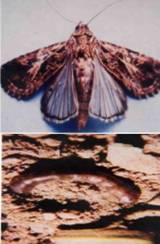
Description: The adult moths are medium sized with wing expanse 45 – 55mm, dark greenish-brown with reddish tinges and have grayish-brown wavy lines and spots on fore wings, hind wings hyaline having dark terminal fringe. A female lays up to 800 eggs in batches of 30 – 50 on the lower surface of leaves, on the parts of the stem touching the ground and in moist soil surface of the crop field. Eggs hatch out within 2 – 9 days depending upon temperature. The very young larvae feed on the fallen leaves or on leaves touching the ground. The larvae become full-grown in 28 – 34 days and pupate in the soil within earthen cells. The pupal stage lasts for 10 – 30 days depending on weather condition.
Damage: The larvae remain hidden under the soil during daytime and come out in the night to damage the eggplant seedlings by cutting at the base of their stems little below the ground level. Cut seedlings are found fallen on the ground of the infested filed. In case of heavy infestation replanting of the crop becomes necessary. The insect hardly causes any damage to the crop in summer and rainy season.
IPM tactics and Control Measures: (i) Irrigating with kerosene oil (5-7 liter kerosene / ha), (ii) using of poison bait made of 2.0 g of Sevin 85 WP or Padan 50 SP in 100 kg rice / wheat bran in sufficient water to make a non-sticky mixture for 1 ha or (iii) spraying of Dursban / Pyriphos 20 EC at 5.0 ml / liter of water on the soil around the seedling in the evening.
Epilachna Beetle, Epilachna vigintioctopunctata Fab. and E. dodecstigma: Coccineliidae, Coleoptera
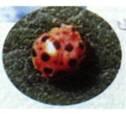
Description: The adult insect looks oval shaped possessing black spots on back and often found along with grubs. A female lays yellow eggs in batches of 60 – 90 during summer and 20 – 30 during winter on the dorsal surface of leaves. Eggs hatch out within 3 – 4 days. The larvae after 8 – 10 days of feeding and moulting three times become full grown measuring 6 mm long, then pupate on the leaves or stems. The life cycle lasts for 15 - 20 days and completes few generations in the same season.
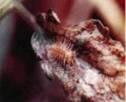
Damage: Both grubs and adults of the insect feed on the leaves by scraping the leaf surface leaving the midrib. They also feed on the epidermis of leaves. As a result, the infested leaves dry and fall off. They may also feed on the fruit surface or make small bores in fruits.
IPM tactics and Control Measures: (i) Hand-picking and destruction of eggs, grubs and adults (ii) clean cultivation by removing and destroying plant debris, infested leaves, infested fruits etc. and (iii) in case of severe infestation spraying of Sevin / Carbaryl 85 WP @ 2.0 g / liter of water on the affected leaves at an interval of 15 days.
Jassid, Amrasca biguttula biguttula, Distant: Jassidae, Homoptera
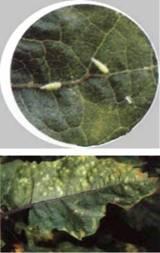
Description: The slender pointed bodied greenish yellow adult insect measures 1 – 3 mm long and has tow distinct black spots at distal end of wings. The legs are provided with few rows of sharp thorns. They have about 5 - 7 weeks longevity. A female lays 15 – 20 eggs within the main veins and at the lower surface of leaves. Incubation and nymphal periods range from 4 – 10 and 7 – 21 days respectively. The insect completes it life cycle within 11 – 31 days with 10 – 12 overlapping generations.
Damage: Both the nymphs and adults of the hopper cause serious damage to the leaves by sucking the cell sap. The small nymphs suck sap from the lower surface of the leaves. The infested leaves wrinkle through the blades, the blades turn yellow and show burn symptom and ultimately the whole leaf turns yellow. Heavily infested leaves appear stunted, show yellow mosaic and subsequently dry up. The fruit bearing declines seriously in heavily affected plants.
IPM tactics and Control Measures: (i) Growing resistant varieties viz. ISD006, BL114 & BL095(2), (ii) Conservation of natural enemies by minimizing chemical pesticides spraying and (iii) in case of severe infestation, Spraying of neembicidine @ 4 ml/l of water or neem oil @ 20 ml/l of water.
Leaf Roller, Eublemma olivacea, Gi.: Noctuidae, Lepidoptera
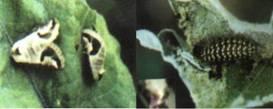
Description: The adult insect measures 1 – 3 mm long, velvety greenish moth. A female lays eggs in batches of 8 – 22 on the ventral surface of leaves. Eggs hatch into violet-brown larvae having several creamy raised heaps on back and long hairs on back and surrounding areas. The caterpillar pupates within rolled leaf in about 4 weeks. The insect may have 3 – 4 generations in a year under favourable weather conditions.
Damage: The caterpillars feed by chewing within young rolled leaves. The affected young leaves appear silky networked and rolled. The rolled leaves initially turn brown and ultimately dry up. Under severe condition the entire plant turn brown and leaves droop off.
IPM tactics and Control Measures: Not available.
Red Mite, Tetranychus urticae: Acarina
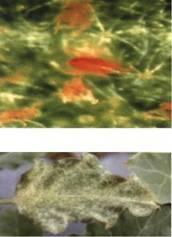
Description: The mite is very small, red in colour and hard to find with naked eye. They are mainly found underneath the leaves but move to upper surface of leaves, stems and flowers when enormous in number. The female mites lay invisible miniature eggs on the lower surface of leaves. Eggs hatch into orange larvae, which feed on the lower surface of leaves and develop within a week into deep orange or red adult mites resembling spider.
Damage: The mite affected leaves show yellowish clumpy spots. In case of severe infestation, the leaves wrinkle, turn complete yellow to brown and ultimately droop off.
IPM tactics and Control Measures: (i) Collection and destruction of the affected leaves along with mites (ii) in case of severe infestation spraying of Ethion or Nuron or Tork 550 SC@ 2 ml/L of water at 10 days interval.
Thrips, Thrips palmi

Description: Thrips look pointed and slender. The insects are minute and fragile but can be found with naked eye. The adult insect is reddish yellow with two pairs of fringed wings and two long brown spots on back. They are very fast and fly off just at leaf touch. Immature insects are white or yellow in colour. The female adults lay eggs deep into the leaf tissue. Eggs hatch into larvae within few days and pupate generally in soil at plant base.
Damage: Both nymphs and adults lacerate the leaf tissues and lap the oozing sap. As a result, white silvery sheens appear on the infested leaves. In case of severe infestation, the leaves start drying from tip downwards.
IPM tactics and Control Measures: Described in case of country bean.
Aphids, Aphis gossypii Glover: Aphididae, Homoptera
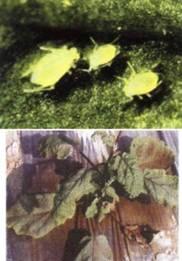
Description: The aphids are soft bodied yellowish insects each measuring 1.0 – 1.5 mm with two cornicles at the abdomen. Initially they are found on the lower surface of the leaves but move to the upper surface, stem and flower when they increase in enormous number. They multiply by parthenogenesis instead of reproducing through eggs. These immature insects develop into adult aphid within a week and start producing next generation.
Damage: At the initial stage the affected leaves generally turn yellow. At severe infestation, the young leaves wrinkle downward. The upper surface of leaves become covered with a sticky black mould known as sooty mould. This causes stunted growth of the plant and the plant remains dwarf.
IPM tactics and Control Measures: Described in case of country bean.
White Fly, Bemisia tabaci Genn.: Aleurodidae, Homoptera
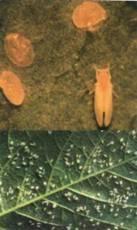
Description: The adult white fly measures slightly longer than 1 mm and live on the lower surface of leaves. The adult insects upon slight disturbance fly away short distance. The female adults lay oval shaped miniature eggs up to 160 in few batches on the lower surface of leaves. Eggs hatch into flat oval shaped nymph. The full-grown nymphs measure less than 1 mm. The nymphs suck cell saps, and are sessile at feeding. The insect completes as many as 15 generations in each crop season.
Damage: The affected leaves show yellowish clumpy spots. In case of numerous insects, several clumpy spots coalesce together and the leaves along with green midribs turn yellow. The nymphs during feeding secrete sticky honey like substance that cover-up the upper parts of the leaves and flowers. The plants become stunted. The insect does more harm by disseminating diseases than does by feeding.
IPM tactics and Control Measures: Not available.
Eggplant Shoot and Fruit Borer, Leucinodes orbonalis Guen.: Pyralidae, Lepidoptera

Description: The adult insect is a white moth having brown spots on wing. A female moth lays 10 - 60 creamy white eggs singly on shoots, flower buds, near the peduncle of fruits and on the lower surface of leaves during the later part of the night to the early hours of the morning. The eggs hatch into dark white larvae and gradually become light rose with ages.
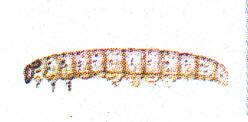
The full-grown larvae measure 15 - 18 mm and come out of the infested shoots and fruits for pupation in the dried shoots and leaves or in plant debris fallen on the ground. The incubation, larval and pupal periods are 3 - 5, 12 - 15 and 7 - 10 days during summer, while it is 7 - 8, 14 - 22 and 13 - 15 days during winter season.
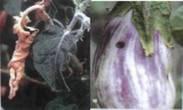
Damage: This is the most serious pest of eggplant. The larva starts infesting eggplant from its very young stage and continues up to the last day of the crop’s life. In the vegetative phase of the plant, the larvae bore into the young shoots, petioles and midribs of the large leaves and feed on the internal tissues from within the attacked plant part. The infested shoots droop down and subsequently wither. In the reproductive phase when the plants start bearing flower and fruits, the larvae bore into the flower buds and fruits. The infested flower buds drop and fruits show the sign of infestation from the oozed out frass of the larvae through the holes made on the fruit by the larvae prior to their jumping out of the fruits upon attaining maturity. The larvae while feeding on the internal soft tissues of the fruit often make tunnels inside the fruit and make the fruit unfit for consumption.
IPM tactics and Control Measures: As the eggplant is grown year-round in almost every corner of the country and the pest has overlapping generations, it is really difficult to manage the pest by a single method. A combination of methods is of paramount importance to keep the pest population below economic injury level for minimizing the yield loss. The combination of methods include the followings: (i) cultivation of tolerant eggplant varieties such as ISD006, BL114 & BL095(2), or growing grafted seedlings, (ii) growing healthy seedlings raised in plots covered with cloth nets or grown in pest free area, (iii) practicing adequate field sanitary measures particularly removing the fallen leaves, buds or debris, (iv) clipping off and destroying the infested shoots and fruits once in a week starting immediately after 2 - 3 weeks of planting and continuing up to final crop harvest, (v) undertaking weekly field checking to spot out the presence of the insect in the field, (vi) placing sex pheromone ((E)-11-hexadecenyl acetate and (E)-11-hexadecen-1-ol, mixed in 10:1 ratio} traps each at 10 - 15 cm distance and just above the crop canopy covering the entire plot starting after 3 - 4 weeks of planting and continuing up to final harvest for reducing the pest population through mating disruption as well as mass catching, (vii) conservation of natural control agents such as Trathala flavo-orbitalis, Camponotus compressus, earwig, lady beetle, mantid and spider by avoiding the prophylactic application of insecticides, (viii) application of insecticides (such as carbosulfan, cypermethrin etc.) only if the infestation is too high even after the above adoption of measures and (ix) ensuring of community approach for all the suggested tactics to maximize benefits.
Brief Description of Sex Pheromone Water Trap

The sex pheromone bait trap comprises the pheromone bait and the locally fabricated water trough. The whole system consists of a 3-liter capacity, 22 cm tall rectangular or round clear plastic container and sex pheromone. Two triangular openings each one of 10-12cm heights is cut 4-5cm away from the bottom on opposite side of the plastic container. Soapy water of 3-4cm height is maintained inside the container throughout the season. A plastic tube containing the pheromones (E)-11-hexadecenyl acetate and (E)-11-hexadecen-1-ol mixed in 10:1 ratio, is hung through the center of the lid of the plastic container by means of a thin wire in such a way that the tube remains only 2-3cm above the soapy water. The traps thus prepared should be placed at 10 – 15 cm distance and just above the crop canopy covering the entire plot starting after 3 – 4 weeks of planting and continuing up to final harvest for reducing the pest population through mating disruption as well as mass catching. Such plastic pheromone traps, if carefully used, may remain useful for 2-3 crop seasons.
Integrated Insect Pest Management: Among the insect pests mentioned above, the Epilachna beetle and red mites other than the most severe pest eggplant shoot and fruit borer cause significant crop damage. But so far management or control measures are not available for the key pests of eggplant considered altogether.
IPM of Cucurbits
Cucurbits form the largest group of vegetables including sweet gourd, bitter gourd, ribbed gourd, sponge gourd, teasel gourd, white gourd, ash gourd and cucumber as the major ones. The insect pests that infest all cucurbits are almost common. However, their infestation intensity may vary to some extent in different cucurbits. Among all, Fruit fly is the severe pest common to all cucurbits. The other major insect pests of cucurbits are Epilachna beetle and Pumpkin beetle.
Epilachna Beetle
Same as described under eggplant.
Pumpkin Beetle, Raphidopalpa (Aulacophora) foveicollis (Lucus), R. abdominalis (F.) and R. frontalis (Baly): Chrysomelidae, Coleoptera
Description: Adult beetles are 6 – 8 mm long, having glistering yellowish-red to yellowish-brown elytra that are uniformly covered with fine punctures. A female adult lays 150 – 300 eggs. Eggs are laid in the moist soil usually around the host plant. Eggs are spherical in shape and yellowish-pink in colour. Freshly hatched grubs are dirty white in colour while full-grown ones are creamy-yellow and about 22mm long. Pupae are pale white and are found in earthen cells 15 – 25mm deep in the soil.
Damage: The adult beetles cause damage to young seedlings by feeding on leaves making shot holes. On hatching, the grubs start feeding on the roots. They live in the soil and cause damage to seedlings and mature plants feeding on roots. The damage at the young stage may even kill the seedlings.
IPM tactics and Control Measures: (i) Scouting the plot in the morning for collecting and destroying the adults, (ii) spraying of Sevin/Carbaryl 85WP at 2.0g/litre of water at 7 days interval and (iii) in case of severe infestation, applying Diazinon 14G @ 5g/plant and mixing with soil around the plant followed by light irrigation.
Melon Fruit Fly, Bactrocera cucurbitae Coquillett: Tephritidae, Diptera

Description: The fruit fly adults are free living, reddish brown with lemon yellow in colour, having curved vertical markings and fuscous shading on the outer margin of the wings. The adult female lay eggs usually just below the epidermis of the fruits by inserting their ovipositor. The eggs are laid singly or in clusters of 4 to 10. A single adult can lay 42 to 58 eggs. The eggs hatch within 18 hours in summer and 3 – 4 days in winter. Soon after hatching the young larvae (maggots) bore into the flower buds or into the fruits and start feeding. The full-grown maggots measure 9 – 10 mm long and 2 mm broad across the thorax and are cream or pale white in colour. The full-grown larvae develop into barrel shaped, light brown or pale colour pupae in 0.5 to 3 inches deep in soil within 7 – 14 days. The pupae emerge into adults within 5- 8 days in summer and within about 3 weeks in winter.
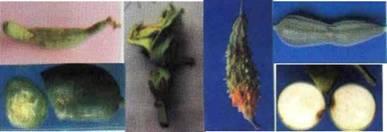
Damage: Generally fruit flies attack the young and tender fruits of various cucurbits like snake gourd, cucumber, sweet gourd, bitter gourd, ribbed gourd, ash gourd etc. Watery juices that come out at the point of puncture later appear as a solidified material. The larvae (maggots) hatched inside the fruits eat away the pulpy tissues inside and make tunnels in fruits and destroy the fruits. The infested fruits are completely destroyed. The damage ranges up to 60% varying significantly in different cucurbits.
IPM tactics and Control Measures: A combination of methods such as (i) plowing well the soil to expose the pupae to birds, (ii) removing and destroying the infested fruits and fallen fruits regularly, (iii) covering of fruits immediately after fruit-set with polythene bag having pin-holes and (iv) spraying cypermethrin at 10 days interval or spraying bait spray made of 1.0 g Dipterex 80SP and 100 g molasses per litre of water or (v) placing above the crop canopy with the support of bamboo sticks the pheromone bait traps each consisting of a 2.5x1.5 cm cotton wad having soaked 15-20 drops of a pheromone bait “Cuelure” {4-(p-acetoxyphenyl)-2 butane} or {4-(3-oxobutyl-phenylacetate)} and hung by a thin wire through the center of a 3-litre capacity and 22cm tall rectangular or round plastic container having two opposite cut holes and containing soapy water of 3-4cm height with a gap of 3-4cm from the hung cotton wad above (vi) using poison bait traps @ 20 to 40 per hectare, each trap made of 100g mashed ripe sweet gourd (MSG) with 0.25g Mipcin 75WP or Sevin 85WP or Dipterex 80SP in 100 ml water placed in a lower smaller earthen pot at 50cm height above ground with another slightly bigger flat earthen plate placed upside-down at 20cm above it as cover, and both placed in a three split bamboo stick erected up anchored in soil. The bait materials i.e. MSG and insecticides should be changed at every 4 days interval.
Brief Description of Pheromone Bait Trap
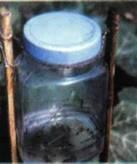
The pheromone bait trap comprises the pheromone bait and the locally fabricated water trough. The whole system consists of a 3-liter capacity, 22 cm tall rectangular or round clear plastic container. A triangular opening is cut in any two opposite sides starting 3-4cm from the bottom. Soapy water of 3-4cm height is maintained inside the container (trap) throughout the season. A cotton wad measuring 2.5x1.5cm and soaked with 15-20 drops of “cuelure” 4-(p-acetoxyphenyl)-2 butane} or {4-(3-oxobutyl-phenylacetate)} is hung through the center of the lid of the plastic container by means of a thin wire in such a way that the cotton wad remains 3-4cm above the soapy water. The trap is then placed just above the crop canopy by means of a bamboo support. The pheromone remains active and continues to attract flies for 2-3 months.
Brief Description of MSG Poison Bait Trap
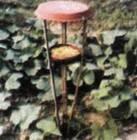
The poison MSG bait is prepared by taking 100g of sliced and smashed ripe sweet gourd in an earthen small container and mixed with 0.25g Mipcin 75WP or Sevin 85WP or Dipterex 80WP and 100ml water. The earthen container, with the above bait materials, is then placed in a cucurbit crop field by mounting it on three bamboo sticks in such a way that the container remains about 50cm above the ground. Finally a flat earthen plate, slightly bigger than the bait containing earthen container, is placed at the top of the three bamboo sticks to protect the bait materials from getting dried by solar heat or wet from rains. A small amount of water should be added to the bait if it gets dried. The MSG bait remains effective for 3-4 days at which time the bait should be replaced with newly prepared MSG.
IPM of Country Bean
Country bean, Dolichos lablab is a popular vegetable grown in winter season and some varieties (IPSA 1 and 2) grown in summer also. Several insect pests infest country bean but the bean pod borer only cause severe damage. The other major insect pests are bean aphids, red mites and thrips.
Bean Thrips, Magalurothrips usitatus (Bagnall): Thripidae, Thysanoptera
Description: Females lay eggs inside the leaf tissue. The hatched larvae feed on leaves and flowers. The full-grown larvae drop on soil and pupate inside soil. They have continuous.
Damage: The insects suck cell sap from reproductive parts and prefer to feed on the flower. They also feed on pollen. Flower and flower parts become brown, dried and in severe case flowers drop or are completely destroyed. The petioles and leaves show tiny holes surrounded by discolored areas. Pods are deformed and yields are reduced.
IPM tactics and Control Measures: (i) Spraying of plain water, (ii) in case of severe infestation, spraying of Pirimor 50 DP at 1.0-1.5 g / liter or Malathion 57 EC @ 2.0 ml / liter of water at 15 days interval.
Black Aphids, Aphis craccivora Koch: Aphididae, Homoptera
Description: The aphids are soft bodied pear-shaped shiny black insects each measuring 1.0 – 1.5 mm with two appendages at the abdomen. Initially they are found on the lower surface of the leaves but move to the upper surface, stem and flower when they increase in enormous number. They multiply by parthenogenesis instead of reproducing through eggs. These immature insects develop into adult aphid within a week and start producing next generation.

Damage: Both adults and nymphs cause damage to plants by sucking the plant sap from leaves, flowers and young fruits. Leaves crinkle or exhibit a yellowish, mottled, or mosaic coloration. They become sticky with patches of black sooty mold growing on them.
IPM tactics and Control Measures: (i) Conservation of natural enemies especially different ladybird beetles, (ii) in case of severe infestation having >50 aphids / plant, spraying of Pirimor 50 DP at 1.0-1.5 g / liter of water or Malathion 57 EC @ 2.0 ml / liter of water at 15 days interval.
Red Mites
Same as described under eggplant.
Bean Pod Borer, Maruca (testulalis) vitrata Geyer: Pyralidae, Lepidoptera
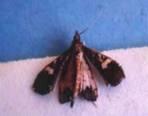
Description: The moths are small, dark gray in colour with white brown patterns of the wings. The colour patterns can be more conspicuous on the forewings, with a silvery white brown spot at the apical margin, than on the hind wings. The males measure about 13 mm in length and 9 mm in width with a wing expansion of about 26 mm. The females have brownish abdomen with bifid hairy ovipositors. The females measure about 11 mm in length and 8 mm in width with a wing expansion of about 23 mm. A female usually oviposits up to 400 eggs during her lifetime, and these eggs are normally deposited in batches of 2 – 6. Eggs are normally deposited on floral buds and flowers, and also on leaves, leaf axils, terminal shoots, and pods. Eggs hatched into larvae within 3 days. The larvae are creamy white in colour, with dark brown head and prothoracic segment. The full-grown larvae measure 15 – 18 mm long with grayish-green or brownish head and yellowish-white body. At night, it emerges from the pods and crawls about. It then descends to the soil and pupates beneath leaf debris. There are two peak periods of abundance of the moths. One is from June to early July and the other, from November to January.
Damage: On hatching the young caterpillar feed on flower buds, flowers and move from one flower to another. Later they web the inflorescence with the adjacent leaves and developing pods and feed within by boring into flowers and pods. The infested flowers either drop, form clusters or/and do not develop into pods while the affected pods become malformed because these are not able to grow normally due to webbing and feeding damage.

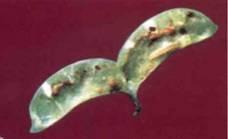
IPM tactics and Control Measures: (i) Conservation of predatory black ants that often feed on the eggs and neonate larvae of the pest, (ii) hand picking of infested flowers and pods at alternative days, (iii) spraying of Neem oil @ 3ml/L of water or Cymbush 10 EC @ 1ml/L of water at seven days interval or application of Sumialpha at a single flower infestation per inflorescence.
IPM of Tomato
Tomato is grown in winter. But recently some varieties are also grown in summer. Tomato is infested by a number of insect pests, which include cutworm, white fly and fruit borer as the major insect pests.
Cutworm and White fly
Same as described under eggplant.
Fruit Borer, Helicoverpa armigera (Hubner): Noctuidae, Lepidoptera.
Description: Adult moths are medium sized with wing expanse 30 – 44mm, stout, ochreous with pale-brown or reddish-brown tinge, fore wings are olive-green to pale brown in colour with a dark brown circular spot in the center and indistinct double waved antmedial lines, hind wings are pale smoky-white with a broad blackish outer border. A female lays 1200 - 1600 eggs. Eggs hatch within 2 – 4 days. Freshly hatched larvae are yellowish-white in colour but gradually change and acquire greenish tinge. Full-grown larvae are 40 – 48mm long, apple-green in colour with whitish and dark-gray broken longitudinal stripes. Pupae are dark brown in colour. Larval and pupal stages last for 15 – 24 and 10 – 14 days respectively. The full-grown larvae drop down from the plant and burrow in the soil where they pupate.
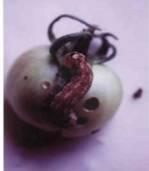
Damage: The hatched larvae feed on leaves and flowers. The advanced stage larvae bore circular holes and thrust only a part of their body inside the fruit and eat the inner contents. If the fruit is bigger in size, only part of it is damaged by the caterpillar. The larvae move from one fruit to another and a single caterpillar may eat and destroy 2 – 8 fruits.
IPM tactics and Control Measures: (i) Field sanitation removing the plant debris and infested fruits, (ii) in case of severe infestation, spraying of Cypermethrin 10 EC @ 1 ml / liter of water or Fenvalerate 20 EC @ 0.5 ml / liter of water at 15 days interval.
IPM of Okra
Okra is grown in summer and winter. The crop is infested by a number of insect pests, which include Jassid, white fly, and shoot and fruit borer as the major insect pests.
Jassid and White fly
Same as described under eggplant.
Shoot and Fruit Borer, Earias vittella (Feb.): Noctuidae, Lepidoptera.
Description: It is a nocturnal insect. The adult moth measures 13 – 15mm long with wing expanse 30 – 34mm, head and thorax ochreous-white, fore wings pale white with a broad wedge-shaped horizontal green patch in the middle and hind wings silvery-creamy-white in colour. A female lays 65 - 695 eggs. The eggs are usually laid singly on buds and flowers and occasionally on fruits and shoot tips. The eggs hatched into larvae within 3 – 9 days. The full-grown caterpillar measures 18 – 24mm. Rain and high humidity directly influence its population development. It needs around a month to complete its life cycle and thus has 12 generations.
Damage: The larvae bore into the tender shoots and tunnel downwards. The infested shoots wither, droop down and ultimately the growing points are killed. The caterpillars then bore into the buds and fruits and feed inside them. The damaged buds and flowers wither and fall down. The affected fruits have bores seen externally; they decay inside, become deformed in shape and remain stunted in growth.
IPM tactics and Control Measures: (i) Clean cultivation removing and destroying the plant debris and infested fruits, (ii) removal of alternate host, especially cotton near the lady's finger field, (iii) conservation of Trichogramma evanescens West and Apantalis parasitoids, and (iv) in case of severe infestation, spraying of Cypermenthrin 10 EC @ 1 ml / liter of water or Fenvalerate 20 EC @ 0.5 ml / liter of water at 15 days interval.
IPM of Cabbage and Cauliflower
Cabbage and cauliflower are grown in winter. The crops are infested by a number of insect pests, which include cutworm, tobacco caterpillar and diamondback moth as the major insect pests.
Cutworm
Same as described under eggplant.
Tobacco Caterpillar, Spodoptera litura (Fab.): Noctuidae, Lepidoptera
Description: It is a nocturnal insect. The adult moths are stout with wing expanse 35 – 45mm, pale ochreous suffused with dark-brown. A female lays on an average 400 eggs in batches of 80 – 150 eggs. The eggs hatched into larvae within 3 - 5 days. The full-grown caterpillar measures 40 – 50mm. The larvae are found aggregated in lower leaves. Pupation takes place in rough earthen cocoons in soil. Pupal stage lasts for 7 – 11 days. The entire life cycle occupies 30 – 40 days in summer and 18 – 20 weeks in winter. Adult longevity is 10 – 24 days.
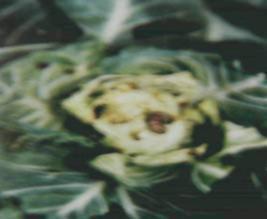
Damage: Many larvae in gregarious form feed inside the infested cabbage head. It at times also tunnels into soft tissues such as soft stems, midribs, leaf stalks etc.
IPM tactics and Control Measures: (i) Hand picking of the egg mass and caterpillars two times, (ii) spraying of Sumithion 50EC, Diazinon 60EC or Dursban 20 EC @ 2ml/L of water before head formation or soon after observing tiny caterpillars on leaves and (iii) for crops to be harvested within 15 days spraying malathion 57EC @ 1.5 to 2.0 ml/liter of water.
Diamondback Moth, Plutella xylostela (Linn.): Plutellidae, Lepidoptera
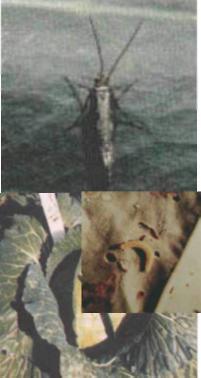
Description: It is a cosmopolitan insect and a major pest of cruciferous crops but prefer cabbage and cauliflower. The adult measures 8 – 10mm long, grayish-brown in colour. There are three pale whitish triangular markings on hind margins of each fore wing and when at rest, a dorsal median patch of three diamond-shaped yellowish-white spots is clearly visible by joining both fore wings-hence called “diamond back”. A female lays 40 – 60 eggs. The eggs hatch into larvae within 3 - 8 days. The full-grown caterpillar measures 8 – 12mm long. Pupation takes place in beautiful transparent cocoons that are fastened to the ventral side of leaves. Longevity of adults is 16 – 18 days. There are 8 – 10 overlapping generations in a year.
Damage: On hatching, the young larvae feed by scrapping epidermal leaf tissues and thus produce typical whitish patches. Advance stage larvae bite holes in the leaves. The infestation is more severe during dry season. It causes retardation of growth resulting in undersized cabbage heads and cauliflower.
IPM tactics and Control Measures: (i) field sanitation by removing and destroying all remnants, plant debris after crop harvest and plowing well, (ii) hand picking of the egg mass and caterpillars two times, (iii) spraying of Bacillus thuringiensis formulation or Cypermethrin 10EC or Fenvalerate 20EC @ 1.0 ml/liter of water.
Cabbage Butterfly, Pieris brassica
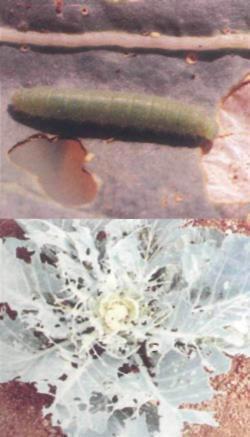
Description: The adult butterflies have snow-white forewings with wing expanse 60 – 70mm. The hind wings are also pure white with black apical spots. A female lays only 2 – 3 egg-masses of 50 – 80 eggs each. The eggs are laid in clusters on upper surface of leaves. The eggs hatch into larvae within 3 – 4 days. The full-grown caterpillar measures 38 – 44mm long, velvety bluish-green in colour. Pupation takes place on leaves and stems.
Damage: It is an oligophagous pest of cruciferous crops but prefers cabbage and cauliflower. On hatching, the young larvae feed gregariously on leaves for a couple of days. The infested leaves are skeletonized, sometimes the caterpillars bore into the heads of cabbage and cauliflower.
IPM tactics and Control Measures: Same as for tobacco caterpillar.
References
- Alam, S. N. 2001. Development of an integrated pest management strategy for the control of eggplant fruit and shoot borer, Leucinodes orbonalis in south Asia. AVRDC – DFID Bangladesh project. HRC, BARI, Joydebpur.
- Alam, S.N., M. A. Rashid, F.M.A. Rouf, R. C. Jhala, J.R. Patel, S. Satpathy, T.M. Shivalingaswamy, S. Rai, I. Wahundeniya, A. Cork, C. Ammaranan and N.S. Talekar. 2003. Development of an integrated pest management strategy for eggplant fruit and shoot borer in South Asia. Shanhua, Taiwan. AVRDC- the World Vegetable Centre. Technical Bulletin No. 28. AVRDC Publication No. 03-548.13 - 23pp.
- Das, G. P. S. Ramaswamy and A. Bari. 2000. Integrated crop management practices for the control of the brinjal shoot and fruit borer in Bangladesh. DAE-DANIDA Strengthening Plant Protection Services (SPPS) Project. Khamarbari, Dhaka.
- Islam, M. 1999. Integrated pests (insects) management of vegetables. Consultancy Report. AVRDC-USAID Bangladesh Project. HRC. BARI, Joydebpur, Gazipur.
- Islam, M. N. and M. A. Karim. 1994. Standardization of the economic threshold level for brinjal shoot and fruit borer, Leucinodes orbonalis Guen., In Annual Res. Report, 1993 – 94, BARI, Gazipur, Bangladesh.
- Nasiruddin, M., S. N. Alam, A. K. M. Khorsheduzzaman, A. Rahman, K. M. Ziaur, A. N. M. Rezaul, H. S. Jasmine and E. G. Rajotte. 2004. Integrated Management of Cucurbit Fruit Fly, Bactrocera cucurbitae Coquillett in Bangladesh. IPM CRSP Bangladesh Site Technical Bulleting No.1. 16p.
- Rahman, M. M. 2000. Pesticides: their uses and problems in context of Bangladesh. In Proceedings of the National Workshop on Conventional and Nuclear Technique for Pesticide Residue Studies in Food and Environment held on 15-19 October, 2000 at IFRB, AERE, Savar.
- Rahman, M. M. 2004. Uses of persistent organic pollutants (POPs) in Bangladesh. Annex III. In Proceedings of Inception Workshop. Inception Report. Bangladesh: Preparation of the Persistent Organic Pollutants (POPs) National Implementation Plan under the Stockholm Convention (POP NIP), Department of Environment. Paribesh Bhaban, Dhaka, Bangladesh.
- Rahman, M. M. 2005. IPM technologies of different crops potential for field trial generated at the Department of Entomology, BSMRAU, Gazipur. Paper presented at IPM Operators Workshop organized by the DANIDA-DAE-SPPS project and held on March 30 at DAE, Khamarbari, Dhaka, Bangladesh.
- Ramsawmay, S. 1997. A summary of Integrated Pest Management Activities and their Impacts in Bangladesh. DAE, Dhaka, Bangladesh.
- Roy, M. 1997. Training Manual on Integrated Pest Management in Vegetables, Jessore, Bangladesh.
- Satter, M. A. and K. S. Uddin. 1996. Country Paper on Integrated Pest Management Activities in Bangladesh, DAE, Khamarabari, Dhaka.